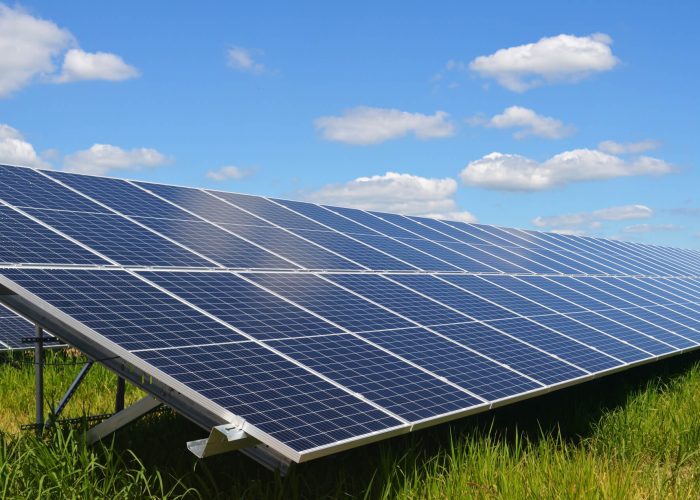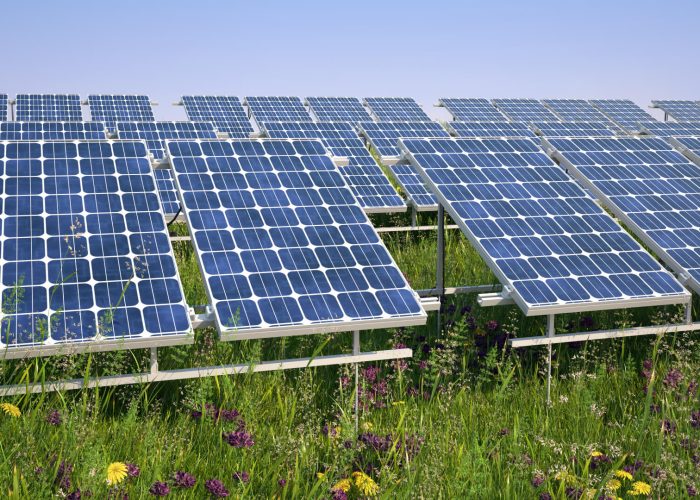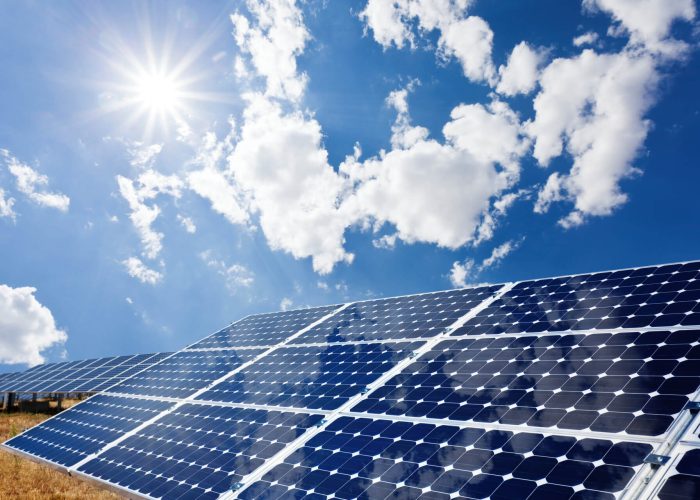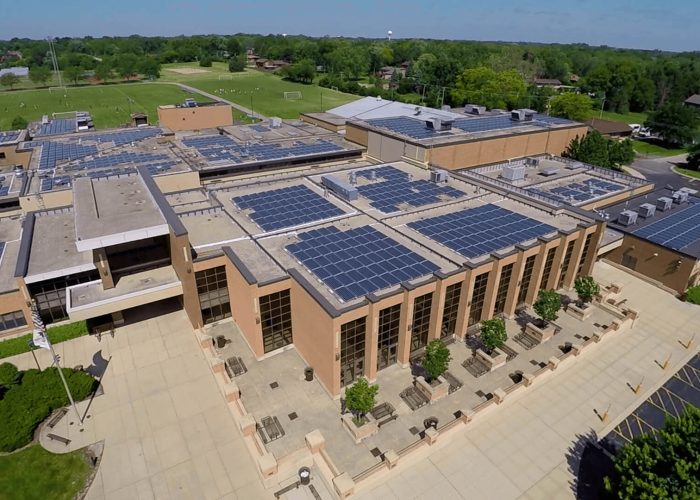Introduction
Solar power has gained significant momentum in recent years, experiencing an average annual growth rate of 24% in the last decade. Due to government incentives, technological advancements, ever-increasing energy demand, and growing environmental concerns, schools, higher education institutions, and local governments across the United States are increasingly turning to solar. They are adopting this renewable energy source to cut energy costs, increase environmental stewardship, and provide learning opportunities for students and the community.
Despite this growth, many misconceptions surround this renewable energy source, holding it back from even greater adoption. In this article, I’ll debunk solar myths and misconceptions I hear to help public owners make informed decisions about their energy choices.
Solar Myth #1: Solar Power Will Power My Building During an Outage
It’s a common myth about solar that panels can power a building during an outage. The belief might arise from the assumption that since solar panels generate electricity from sunlight, they should continue to provide power even when the grid is down.
Solar Fact: Most solar panel systems are grid-tied, meaning they’re designed to shut down automatically during a power outage for safety reasons. There are two key reasons for this. The first is safety. When the power goes out, grid-tied systems are programmed to stop sending electricity into the grid to prevent potential harm to utility workers who might be working to fix the issue. If these systems kept sending power, it could pose a danger to those working on the lines. Secondly, most solar panel systems use inverters designed to synchronize with the grid. When the grid goes down, these inverters stop functioning to avoid any back-feeding of electricity into the grid. This is essential to protect the grid and the workers trying to restore power.
However, some systems can store excess energy in batteries, allowing power to be used when the grid is down. These systems can provide backup power during outages. Still, building owners need to understand the distinctions and consider adding battery storage if they want backup power.
Related Reading: How Do Solar Microgrids Work?
Solar Myth #2: Solar Will Offset My Entire Electricity Bill
There are a variety of reasons building owners may think that solar will eliminate their utility bills. However, that isn’t necessarily the case.
Solar Fact: While solar power can substantially reduce electricity bills, achieving a complete offset often requires a combination of factors, including system size, energy usage, local regulations, and potentially integrating battery storage. In most cases, buildings use more electricity than the solar panels can produce at certain times (like at night), so they’ll still draw power from the grid, incurring charges. Net metering (if available from the local utility) allows excess energy generated during the day to be fed back into the grid for credits, but these may not fully cover all usage. Further utility policies vary, affecting how much owners can offset their bills. Some states limit how much energy can be generated and credited back.
Our in-house solar engineers can work with you to right-size a solar system to your needs. Working with our engineers, we can also offer additional energy conservation measures, such as LED lighting as well as HVAC and controls upgrades that could be implemented first to reduce a building’s overall energy consumption. Then, a new solar array would be sized for the new and lower energy baseline. Improving a building’s energy efficiency with an energy savings performance contract, alongside installing solar can be the best way to maximize savings.
Solar Myth #3: Solar Power is Not Cost-Effective
The notion that solar power isn’t cost-effective can be attributed to several key factors. Misconceptions about upfront costs, efficiency, maintenance requirements, and incentives/financing options have long contributed to this myth. However, that is far from the truth.
Solar Fact: With rising utility rates across the U.S., solar can help lower electricity costs, improving its return on investment and payback. Further, various incentives, such as tax credits and rebates, can help reduce the upfront cost of solar installations. So, over time, public owners, like K-12 schools, cities/towns, and higher education institutions, could save significantly on electricity bills, making solar a cost-effective investment. However, solar pricing (equipment and installation), utility rates, and incentive programs vary from state to state. To find out how much your school or local government could save with solar, contact our team today.
Case Example: Warren Township High School District 121 is saving big with solar. In May 2020, 2.4 MW of solar was energized in the district. As a result of the project, the District will receive approximately $2.5 million in rebates and incentives within the first five years of the project. Additionally, it is anticipated that solar energy will generate enough to account for nearly all the energy usage at the district’s Almond Campus, saving approximately $300,000 in annual operating costs.
Related Reading: What are Solar Financing Options for Schools and Municipalities?
Solar Myth #4: Solar Panels Cause Roof Damage
There are many fallacies surrounding roof-mounted solar arrays. The biggest myth is that installing solar panels can cause roof damage and lead to leaks. However, many building owners with this misunderstanding fail to consider the age and quality of the roof before the installation.
Solar Fact: Properly installed solar panels should never cause a roof leak. They typically protect the roof from the elements and subsequent damage. Before beginning a project, our team works with structural engineers and roofing consultants to consider the structural soundness of roof integrity when proposing, designing, and installing solar arrays. If a roof needs repair, those issues will be addressed before installation to ensure the longevity of the roof and solar systems. Solar panels are typically mounted on removable skids with weighted ballasts that allow easy removal if needed.
Case Example: We’ve designed over 45 solar systems, including dozens of roof-mounted arrays. One roof-mounted solar example is Lake Park High School District 108, which sought solar to offset utility costs. Before the installation, Performance Services assessed the existing conditions of the school buildings’ roofs to ensure the solar arrays wouldn’t cause any issues. The 1.86 MW system reduces electricity use by more than 2.2 million kWh and is distinguished as one of Illinois’s largest solar installations with net metering.
Related Reading: How do you assess leaks on a roof if the solar panels are on it?
Solar Myth #5: Solar is Unreliable and Won’t Work on Cloudy Days
The misconception that solar panels don’t work on cloudy days likely stems from a misunderstanding of how solar panels operate and generate electricity. Solar panels can still generate electricity on cloudy days, albeit at a reduced efficiency compared to sunny days.
Solar Fact: Solar panels are designed to capture both direct and diffused light. While their efficiency is reduced on cloudy days, they can still generate electricity. The exact amount of electricity depends on the degree of cloud cover and the specific solar panel technology. Newer panels are more effective at capturing diffused light. At Performance Services, we use sophisticated and bankable PV modeling to accurately calculate production. This modeling includes location-specific data.
Related Reading: How Do Solar Panels Work
Solar Myth #6: Placing Solar on Land Makes it Unusable for Any Other Purpose
It is easy to see where this myth stems. Visually, ground-mounted solar systems placed on open fields appear to render the land unsuitable for other purposes. However, many may be unfamiliar with the dual uses solar power can provide.
Solar Fact: In reality, ground-mounted solar systems can be designed to coexist with other land uses. For instance, the land beneath solar panels can be used for agriculture (also known as agrivoltaic), grazing, or other activities, such as pollinator fields. Further, solar panels don’t have to be installed on the ground. There are a variety of options that lend themselves to dual uses. For example, solar panels can be installed on roofs to keep land free for other uses. Or they can be designed as parking lot solar canopies or shade awnings to provide shade to parked cars and pedestrians. In both cases, the roofs of these structures are otherwise sunk costs, but with solar panels, they are an investment.
Case Example: Baugo Community Schools installed solar to help offset utility costs. To better fit 1 MW of arrays at the Junior/Senior High School campus, the District installed one ground-mounted system with three aesthetically pleasing solar carport canopies to provide shade throughout the parking lot. This project is the largest solar carport installation for a K-12 school district in Indiana. The energy produced from the panels will offset all electricity usage at the High School, administration building, and the 1929 gym.
Related Reading: Harvesting Sunshine and Encouraging Biodiversity with Solar Pollinator Fields
Solar Myth #7: Solar Panels Can be Visually Intrusive
While this is more of an opinion, it’s still an objection I’d like to address. Some believe solar panels are an eyesore, taking up land and cluttering the landscape or the roof of a building.
Solar Fact: Solar panels can be designed and positioned to minimize the visual impact or out of the line of sight. For example, fence screening can be used around ground-mounted arrays, or pollinator fields can grow native plants for bees, butterflies, and prairie animals to thrive. Better yet, rooftop arrays can be installed as they are difficult to view from ground level due to setbacks. If there is concern over the panels’ look, there are solutions, including solar skins. A solar skin is a thin layer of film that can be laid on top of the panels. The films can be tailored to match the visual aesthetics of a building or property without significantly impacting efficiency.
Alternatively, solar can be celebrated. Organizations wishing to highlight their commitment to sustainability and clean energy can install solar in highly visible areas. Solar panels are designed to be sleek, and they can easily complement the architecture of a building.
Case Example: Kildeer Countryside Community Consolidated School District 96 installed a 1 MW solar array to provide electricity at the County Meadows/Woodlawn School building. To visually integrate the solar system with the property, the District installed fencing around the outer perimeter of the solar field. Additionally, they installed solar skins on the first few visible arrays. The skins feature animal artwork drawn by the Country Meadow/Woodlawn School students.
Solar Myth #8: Solar Panels Use More Energy Than They Produce Over a Lifetime
This myth stems from the idea that solar panels use more energy during manufacturing and installation than they produce over their lifetime. In reality, this is just a misunderstanding of the energy payback period.
Solar Fact: It takes energy to save energy; however, solar power is a sustainable and environmentally friendly energy source in the long run. While it is true that solar panels require energy for their manufacture, transportation, and installation, the energy is typically recouped through electricity generation in a relatively short period, known as the energy payback period. This period has been steadily decreasing as solar panel technology improves. According to the National Renewable Energy Laboratory, the payback period is generally between one to four years, depending on the location and type of solar panel. This short energy payback, paired with panels designed to last several decades, means that solar provides a net energy gain over its lifetime.
Case Example: Michigan City Area Schools installed seven ground-mounted solar arrays across its district. The arrays total 2.83 MW and provide 3,628,000 kWh of energy to the grid. The project was so impactful that the District received a 2018 Governor’s Award for Environmental Excellence in the Renewable Energy Category from the Indiana Department of Environmental Management (IDEM). The solar arrays provide 2.83 megawatts (dc) of clean, renewable energy and, in combination with the LED lighting upgrades, offset approximately 52 percent of combined electricity usage at these locations, with expected net energy savings of $23 million over 30 years, which is significantly more than the initial investment in solar.
Related Reading: Solar Power Is More Environmentally Friendly than Your Blue Jeans
Solar Myth #9: Solar Requires a Lot of Maintenance
This falsity likely stems from outdated information. In the early days of solar technology, maintenance requirements were somewhat higher than they are today. Older systems may have needed more attention, such as cleaning and occasional repairs. However, that’s not the case with today’s technology.
Solar Fact: Solar panels have very few moving parts. They generally don’t require a great deal of maintenance other than periodic inspections to function reliably. Modern panels are designed to be durable and long-lasting. They also can come equipped with remote monitoring that allows owners to keep track of their system’s performance without needing physical maintenance.
Conclusion
Dispelling common myths about solar is crucial for promoting a better understanding of this sustainable energy source. Solar power has come a long way in recent years, and it’s essential to recognize its numerous benefits and growing accessibility. By challenging misconceptions and shedding light on the solar facts, I hope to empower public owners to make informed decisions about adopting solar energy. It offers an environmentally friendly, cost-effective solution to lower energy costs, reduce dependence on fossil fuels, and contribute to a cleaner, more sustainable future. Embracing the truth about solar power can lead us toward a brighter and greener tomorrow.
Are you ready to contribute to a sustainable future with solar power? Contact us today, and our solar team will work with you to design, right-size, and install solar to offset your electricity consumption.

David specializes in working with Kentucky public school districts to leverage the streamlined Design-Build construction process and the funding advantages of Guaranteed Energy Savings Contract (GESC) projects.
David Dowdell Business Development Manager




